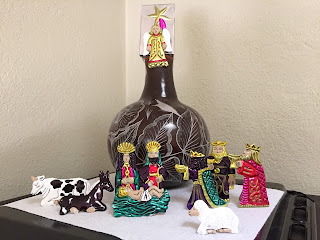 |
| Nacimiento in Our Apartment |
Feliz Navidad y Prospero Ano Nuevo from San Miguel de Allende, Mexico
Why San Miguel and why Mexico? Despite the American press's depiction of Mexico as a dangerous, crime infested place, we have found it to be just the opposite.
 |
| Nacimiento in one of the town squares |
Life in San Miguel is peaceful and stress free. The Mexican people are invariably kind, gracious and welcoming.
The festivities surrounding the holidays are lovely and very sweet, usually involving lots of small children.
 |
| Community Christmas tree in front of Parroquia |
Celebration of the Christmas season is taken very seriously. Starting with the Virgin of Guadalupe Day (December 12) until the arrival of the Three Kings (January 6), the town is filled with decorations, lights and parades.
From December 16 through Christmas eve, many neighborhoods or churches form "Posadas"--a small procession of people walking behind a flat bed truck on which children pose as Mary and Joseph.
 |
| Street doecorations |
They are acting out looking for a place to stay prior to the birth of Jesus. Behind the truck march a small group of musicians and some little children singing a traditional song, which asks for lodging.
They trail through several streets and finally stop at a home which has agreed to host the pilgrims with candy and warm drinks waiting.
 |
| Poinsettias in our apartment |
 |
| Tin tree at entrance to our apartment |
There are a lot of concerts and musical celebrations. One of our favorites was a children's choir presentation at one of the city's oldest Catholic churches, El Oratorio.
We were one of the few gringos in the audience, and although many of the readings and prayers were beyond our Spanish comprehension, most of the the carols were familiar. We took a short video which we thought we would share. (It's probably not viewable on your email, but you can go directly to the blog to see it.)
Of course, we miss being with our family this time of the year, but we know we will see them soon; meanwhile, we content ourselves with snapshots, Skype sessions, and shared photos.
 |
| Snow Day for Bryn & Charlie |
 |
| Charlie's school photo |
 |
| Erin's Christmas Card |
So from our Family to yours--a very Merry Christmas and we hope to see many of you in the New Year!






























